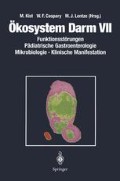Zusammenfassung
Das klinische Management Clostridium difficile-assoziierter Diarrhöen ist nach wie vor mit Problemen behaftet. Die Modifikation der zu über 99% aus Anaerobiern bestehenden intestinalen Kolonisationsflora durch Antibiotika gilt als wesentlicher prädisponierender Faktor. Ein Absetzen der einmal begonnenen antibiotischen Therapie bzw. ein Umsetzen auf weniger begünstigende Substanzen ist aufgrund der klinischen Situation (z. B. Endokarditis) oft nicht möglich. Daneben ist ein ausgeprägter postantibiotischer Effekt zu beobachten, d.h. die physiologische Darmflora erholt sich nur langsam. Bei einzelnen Patienten traten die Durchfälle erst 6 Wochen nach Beendigung der antibiotischen Therapie auf [20].
Access this chapter
Tax calculation will be finalised at checkout
Purchases are for personal use only
Preview
Unable to display preview. Download preview PDF.
Literatur
Bartlett JG (1990) Clostridium difficile: clinical considerations. Rev Infect Dis 12, (suppl 2): 243–251
Brugier S, Patte F (1975) Antagonisme in vitro entre l’ultra-levure et différents germes bactériens. Med Paris 45: 3–8
Bundesanzeiger (1994) Monographie: Trockenhefe aus Saccharomyces cerevisi HANSEN CBS 5926 (Synonym: Saccharomyces boulardii). Bundesanzeiger 71: 40491
Buts JP, Bernasconi P, van Craynest MP, Maldague P, de Mayer R (1986) Response of human and rat small intestinal mucosa to oral administration of Saccharomyces boulardii. Pediatr Res 20: 192–196
Buts JP, Bernasconi P, Vaerman JP, Dive C (1990) Stimulation of secretory IgA and secretory component of immunoglobulins in small intestine of rats treated with Saccharomyces boulardii. Dig Dis Sei 35: 251–256
Buts JP, de Keyser N, de Raedemaeker L (1994) Saccharomyces boulardii enhances rat intestinal enzyme expression by endoluminal release of polyamines. Pediatr Res 36: 522–527
Corthier G, Dubos F, Ducluzeau R (1986) Prevention of Clostridium difficile induced mortality in gnotobiotic mice by Saccharomyces boulardii. Can J Microbiol 32: 894–896
Czerucka D, Nano JL, Bernasconi P, Rampal P (1989) Résponse à la toxine cholérique de deux lignées de cellules épithéliales intestinales. Effet de Saccaromyces boulardii. Gastro¬enterol Clin Biol 13: 383–384
Czerucka D, Nano JL, Bernasconi P, Rampal P (1991) Response aux toxines A et B de Clostridium difficile d’une lignée de cellules épithéliales intestinales de rat: IRD 98. Effet de Saccharomyces boulardii. Gastroenterol Clin Biol 15: 22–27
Elmer GW, McFarland LV (1987) Suppression by Saccharomyces boulardii of toxigenic Clostridium difficile overgrowth after Vancomycin treatment in hamsters. Antimicrob Agents Chemother 31: 129–131
Elmer GW, Corthier G (1990) Modulation of Clostridium difficile induced mortality as a function of the dose and the viability of the Saccaromyces boulardii used as a preventative agent in gnotobiotic mice. Can J Microbiol 37: 315–317
Elmer GW, Surawicz CM, McFarland LV (1996) Biotherapeutic agents. A neglected modality for the treatment and prevention of selected intestinal and vaginal infections. JAMA 275: 870–876
Fekety R, Shah AB (1993) Diagnosis and treatment of Clostridium difficile colitis. JAMA 269: 71–75
Gorbach SL, Chang TW, Goldin B (1987) Successful treatment of relapsing Clostridium difficile colitis with Lactobacillus GG. Lancet 2: 1519
Kelly CP, Pothoulakis C, LaMont T (1994) Clostridium difficile colitis. N Engl J Med 330: 257–262
Klein SM, Elmer GW, McFarland LV, Surawicz CM, Levy RH (1993) Recovery and elimination of the biotherapeutic agent, Saccharomyces boulardii, in healthy human volunteers. Pharm Res 10: 1615–1619
Krammer M, Karbach U (1993) Antidiarrheal action of the yeast Saccharomyces boulardii in the rat small and large intestine by stimulating chloride absorption. Z Gastroenterol 31 (suppl 4): 73–77
Loeschke K, Ruckdeschel G (1992) Durchfälle unter Antibiotika: Diagnostik und Therapie. Dt Ärztebl 89: B221–B224
McFarland LV, Surawicz CM, Greenberg RN, Fekety R, Elmer GW, Moyer KA, Melcher SA, Bowen KE, Cox JL, Noorani Z, Harrington G, Rubin M, Greenwald D (1994) A randomized placebo-controlled trial of Saccharomyces boulardii in combination with standard antibio¬tics for Clostridium difficile disease. JAMA 272: 1913–1918
McFarland LV, Surawicz CM, Greenberg RN, Elmer GW, Moyer KA, Melcher SA, Bowen KE, Cox JL (1995) Prevention of ß-lactam-associated diarrhea by Saccharomyces boulardii compared with placebo. Am J Gastroenterol 90: 439–448
Müller J, Remus N, Harms KH (1995) Mycoserological study of the treatment of paediatric cystic fibrosis patients with Saccharomyces boulardii (Saccaromyces cerevisiae Hansen CBS 5926). Mycoses 38: 119–123
Pothoulakis C, Kelly CP, Joshi MA, Gao N, O’Keane CJ, Castagliuolo I, LaMont T (1993) Saccaromyces boulardii inhibits Clostridium difficile Toxin A binding and enterotoxicity in rat ileum. Gastroenterol 104: 1108–1115
Salyers AA, Whitt DD (1994) Pseudomembranous colitis. In: Bacterial pathogenesis. A molecular approach. ASM Press, pp 282–289
Seal D, Borriello SP, Barclay F, Welch A, Piper M, Bonnycastle M (1987) Treatment of relapsing Clostridium difficile diarrhea by administration of a nontoxigenic strain. Eur J Clin Microbiol 6: 51–53
Surawicz CM, Elmer GW, Speelman P, McFarland LV, Chinn J, van Belle G (1989) Prevention of antibiotic-associated diarrhea by Saccharomyces boulardii: A prospective study. Gastroenterol 96: 981–988
Surawicz CM, McFarland LV, Elmer GW, Chinn I (1989) Treatment of recurrent Clostridium difficile colitis with Vancomycin and Saccharomyces boulardii. Am J Gastroenterol 84: 1285–1287
Trede M, Rask-Madsen J (1989) Bacteriotherapy for chronic relapsing Clostridium difficile diarrhea in six patients. Lancet 1: 1156–1160
Vidon N, Huchet B, Rambaud JC (1986) Influence de Saccaromyces boulardii sur la sécrétion jéjunale induit chez le rat par le toxin cholérique. Gastroenterol Clin Biol 10: 13–16
Editor information
Editors and Affiliations
Rights and permissions
Copyright information
© 1996 Springer-Verlag Berlin Heidelberg
About this paper
Cite this paper
Schmidt, HU. (1996). Interaktionen zwischen Clostridium difficile und Saccharomyces boulardii. In: Kist, M., Caspary, W.F., Lentze, M.J. (eds) Ökosystem Darm VII. Springer, Berlin, Heidelberg. https://doi.org/10.1007/978-3-642-80327-7_6
Download citation
DOI: https://doi.org/10.1007/978-3-642-80327-7_6
Publisher Name: Springer, Berlin, Heidelberg
Print ISBN: 978-3-540-61817-1
Online ISBN: 978-3-642-80327-7
eBook Packages: Springer Book Archive

